Heterotrophic Nutrition: Heterotrophs are species that cannot produce their own food from inorganic sources and they rely on other organisms/autotrophs for their food. The words ‘hetero’ signify ‘other’ and ‘troph’ signifies ‘nutrition’ respectively. Nutrition is classified into two types: autotrophic nutrition and heterotrophic nutrition. In the autotrophic mode of nutrition, organisms use simple inorganic components like water and carbon dioxide to make their own food in the presence of sunshine and chlorophyll. Heterotrophic organisms are those that are unable to grow food and have to depend on other species in order to survive. In this post, we shall discuss the Heterotrophic Nutrition, Types, and examples in detail.
What is Heterotrophic Nutrition?
Nutrition is a discipline of biology that explores how organisms gain energy from food. Nutrition is divided into two categories: autotrophic nutrition and heterotrophic nutrition. In simple terms, heterotrophic nutrition is the style of nutrition in which certain species must utilise other organisms to survive and grow. Animals, fungi, and bacteria are all examples of heterotrophs. Humans and other vertebrates rely on organic, solid, or liquid food to generate energy. Fungi, for example, rely on the conversion of dead organic matter into nutrition. Heterotrophs, in a nutshell break down complicated food into easily digestible parts.
Heterotrophic Nutrition Diagram
Review the below Heterotrophic nutrition diagram how autotrophs produce food and heterotrophs use them as food to survive.
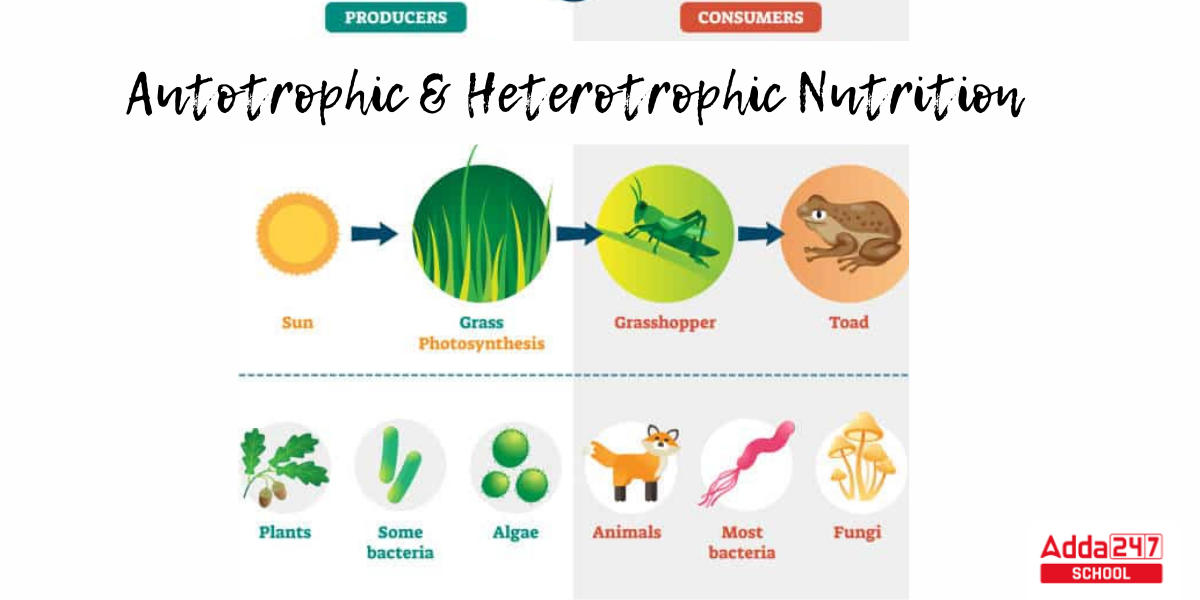
Types of Heterotrophic Nutrition
The heterotrophic nutrition can be classified based on the supply of nutrition as follows –
- Holozoic Nutrition
- Saprophytic Nutrition
- Parasitic Nutrition
Saprophytic nutrition: Organisms receive nutrients from dead and decomposing organic substances in this way of nutrition. Saprophytes are the name given to these creatures. Yeast is an example.
Parasitic nutrition: The organism lives within or outside the body of another creature in this mode. It consumes the other organism’s nutrients without killing them. Parasites are such organisms. Ascaris (roundworms) are parasites that live on the human body.
Holozoic nutrition: Holozoic nutrition is exhibited by organisms that feed on complex materials. This substance is digested, and nutrients enter the body as a result. Humans as an example
Holozoic Nutrition
Holozoic nutrition refers to an organism’s internal breakdown and ingestion of liquid as well as solid food. Food is slowly broken down into smaller organic particles during this step via the process of digestion. After beneficial particles and nutrients have been absorbed, unnecessary and ingested particles are expelled from the body via the elimination process. Ingestion, digestion, absorption, assimilation, and elimination are the five phases involved. Humans are a great illustration of holozoic diet.
Example – Under the category of animals that display holozoic nutrition are all vertebrates. Aside from them, certain unicellular species, such as the amoeba, demonstrate holozoic feeding.
Understand Holozoic Nutrition with Example of Amoeba
Amoeba is a single-celled creature with holozoic feeding. As an example, look at the holozoic nutrition mechanism of an amoeba.
- The amoeba first encircles the food by projecting its pseudopodia, then engulfs it using the phagocytosis process.
- Following that is the digesting phase, which happens when amoeba food vacuoles rich with digestive enzymes help break down the food into smaller and more easily digested components.
- The cytoplasm then absorbs the digested meal while discarding the unprocessed particles.
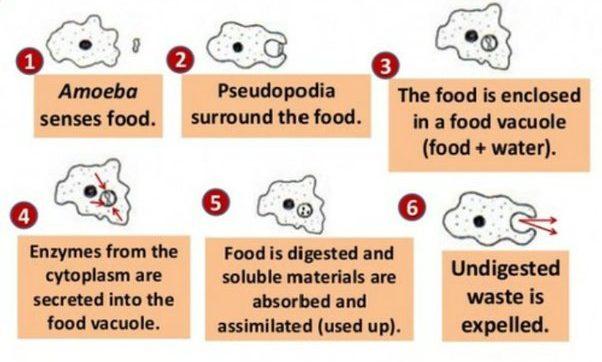
- The food that has already been absorbed, on the other hand, is used to generate energy, which aids in the development and growth of the cell.
- Finally, the mechanism of holozoic nutrition in amoeba finishes when the cell membrane ruptures, allowing undesirable and undigested food particles to be excreted.
Holozoic Nutrition Types
Holozoic nutrition is divided into three categories. These three types are briefly explored below.
Herbivores –
Herbivores are creatures that only consume plants for energy. They are generally referred to as primary producers. Cows, buffalos, goat, deer, and other herbivores are examples.
Carnivores –
Carnivores are animals that feed on, consume, or are dependent on other animals for nourishment. Carnivores include tigers, wolves, and lions, among others.
Omnivores –
Omnivores are creatures that devour both vegetation and animals. Humans, birds, and dogs are examples of omnivores.
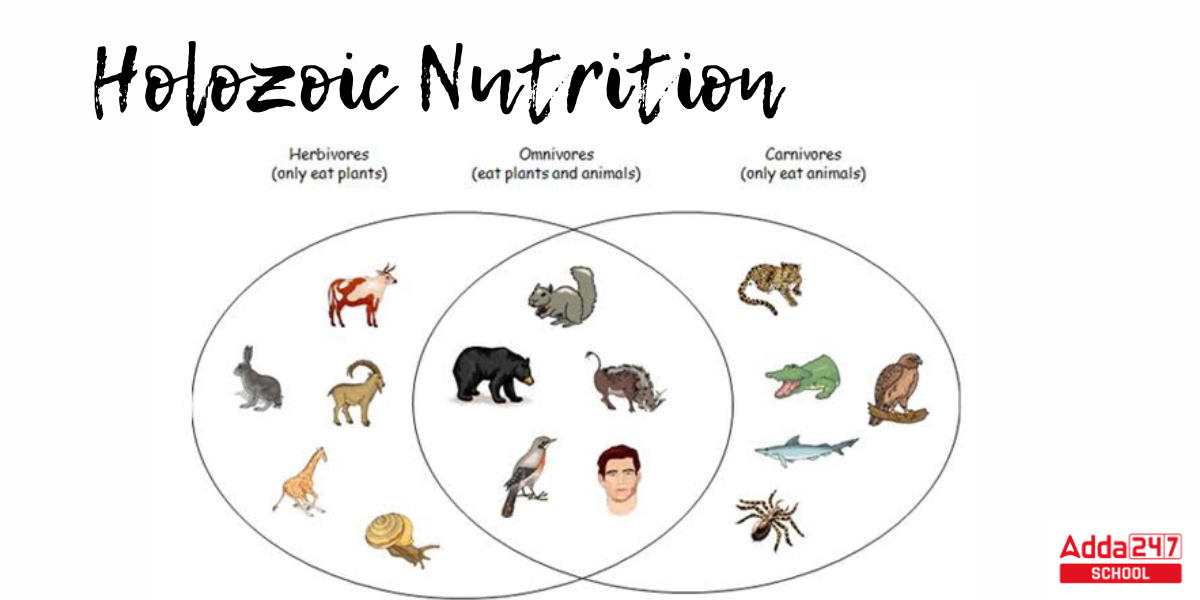
Saprophytic Nutrition
Animals in Saprophytic Nutrition consume dead and decaying matter for sustenance. Saprophytes are organisms that feed using a saprophytic mode of feeding. Fungi are frequently connected with this type of nutrition. They disassemble the substance into composites. Saprophytes play a vital role in the ecosystem since they help to keep the environment and surroundings clean and free of undesired waste, as well as aid in the process of nutrient recycling.
Example – Fungi are frequently connected with this type of nutrition. They separate the substance into composites. Proteins, for example, are broken into smaller amino acid compounds. Fatty acids and glycerol are formed from lipids. Cellulose, which makes up the majority of plant cells and eventually decays, is broken down into glucose.
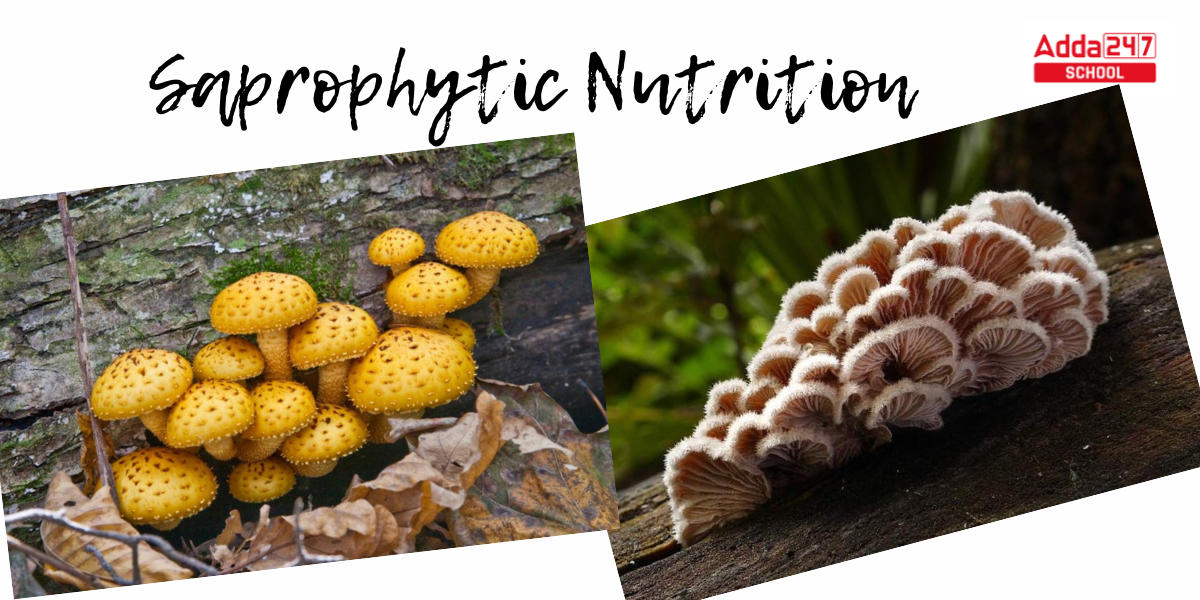
How Saprophytes does Saprophytic Nutrition?
Saprophytic nutrition is accomplished by a series of stages. Lets understand the process in a simple way.
- Saprophytic organisms such as fungus and certain bacteria secrete enzymes onto decomposing organic materials.
- These enzymes breakdown of complex chemical molecules such as proteins, carbohydrates, and lipids into simpler ones.
- Saprophytes absorb the resulting nutrients and tiny molecules through their cell walls or membranes after the organic matter has been broken down.
- These nutrients are subsequently transferred into their cells and used to produce energy, grow, and reproduce.
- Saprophytic organisms serve an important part in the decomposition of dead organic material, assisting in the recycling of nutrients back into the ecosystem.
Saprophytic Nutrition Types
Saprophytic Fungi – The most recognised saprophytic creatures are fungi. They secrete enzymes that degrade organic materials, and their mycelium (thread-like structures) absorb the nutrients that result.
Molds, yeasts, and mushrooms are among examples.
Saprophytic Bacteria – Some bacteria are saprophytic as well. They secrete enzymes that degrade organic molecules before absorbing the breakdown products.
Some Clostridium and Bacillus species are examples.
Actinomycetes – Actinomycetes are filamentous bacteria with growth patterns similar to fungus. They are important in the breakdown of resistant plant components such as cellulose and lignin.
Parasitic Nutrition
A parasite is a living entity that is dependent on another live organism which is called the host organism. Parasites frequently obtain their calories and nutrients straight from the host, which can be damaging to the host’s health and may even result in the host’s death. A parasite has no nutritional benefit for the host and solely causes harm to it. They occasionally murder the host on occasion. Parasitic nutrition refers to nutrients obtained in this manner.
Example – Fungi, plasmodium, lice on human heads, tapeworms, Cuscuta plants, barnacles, and other organisms exhibit this sort of nutrition.
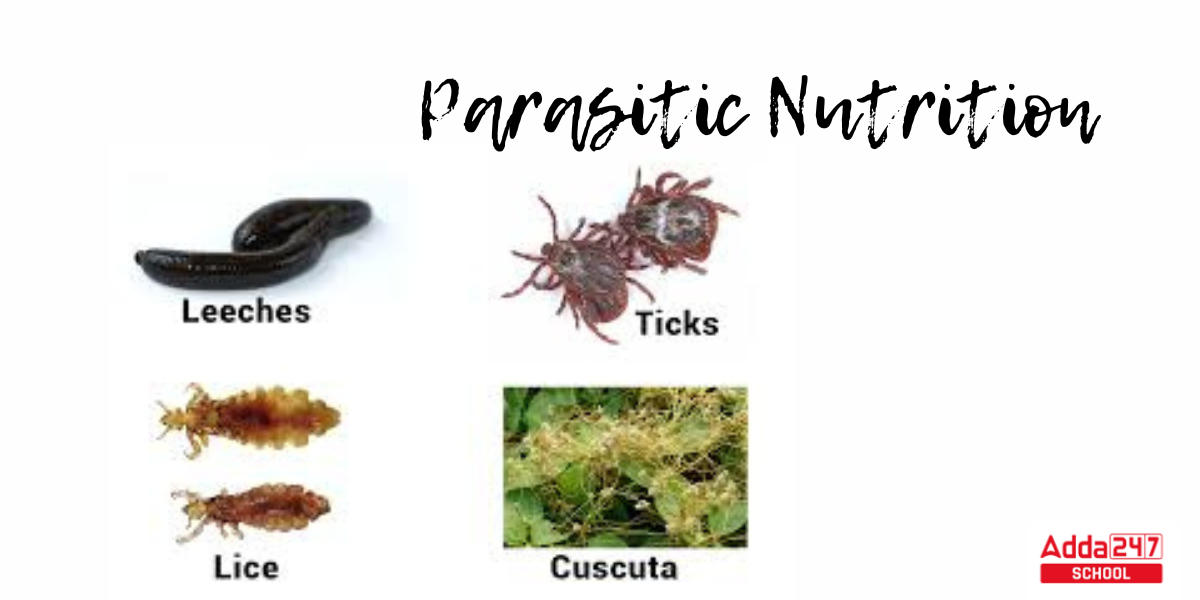
Parasitic Nutrition Type
parasites or parasitic nutrition are classified into two types:
EctoParasites – These parasites live outside the host’s body and get their food and energy from their host.
Ectoparasites include bed bugs, lice, ticks, and mosquitoes.
Endoparasites – These parasites live inside the host organism’s body and get their food and energy from it.
Endoparasites include tapeworm, Ascaris, Plasmodium vivax, and others.
Other – Cymothoa exigua, sometimes known as the tongue-eating worm, is an example of a highly uncommon parasite. This parasite is usually found in the mouth of the fish Lithognathus; it shuts off blood supply to the tongue. As a result, it is entirely severed and falls off.
Example of Heterotrophic Nutrition
Heterotrophic nutrition refers to the mode of nutrition in which organisms obtain their organic compounds and energy by consuming other organisms or their byproducts. In simple terms, heterotrophs are organisms that cannot produce their own food through photosynthesis or other self-sustaining processes and instead rely on external food sources. Humans and most animals are examples of heterotrophic organisms. Here’s an example of heterotrophic nutrition using humans:
Heterotrophic nutrition Example: Humans
Humans are heterotrophic organisms because they cannot synthesize their own food through photosynthesis. Instead, they rely on consuming a variety of other organisms, both plants and animals, to obtain the necessary nutrients and energy for survival. Humans consume plants for essential nutrients, such as vitamins, minerals, and carbohydrates, as well as animals for proteins and other nutrients. The digestion process breaks down these complex organic molecules into simpler forms that the body can absorb and utilize for various physiological processes, including growth, energy production, and maintenance of bodily functions.
In this example, humans are heterotrophic because they obtain their nutrition by consuming a diverse range of organic matter from different sources, as opposed to autotrophic organisms like plants that can produce their own food using sunlight and inorganic compounds.

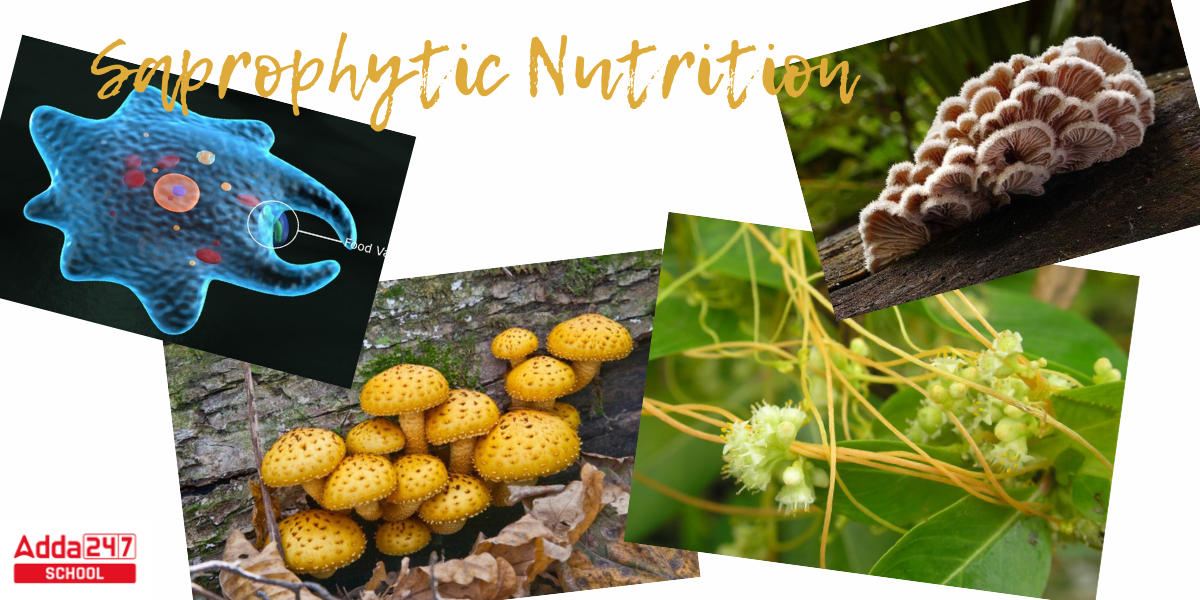







 HPBOSE Compartment Date Sheet 2025 Out, ...
HPBOSE Compartment Date Sheet 2025 Out, ...
 RUHS Counselling 2025 Round 1 Seat Allot...
RUHS Counselling 2025 Round 1 Seat Allot...
 Bihar Board Dummy Registration Card 2026...
Bihar Board Dummy Registration Card 2026...










